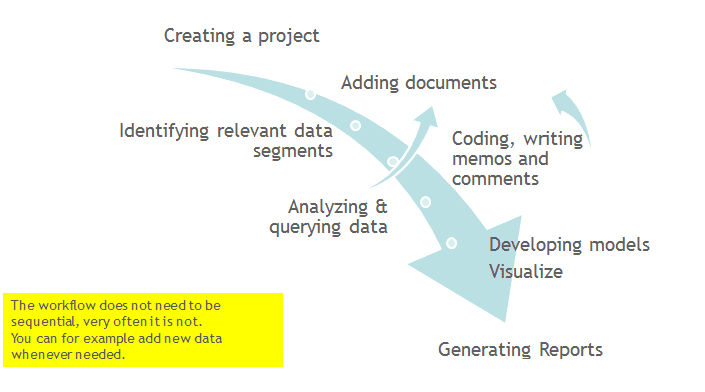Main Steps in Working with ATLAS.ti
Data and Project Management
A first important but often neglected aspect of a project is data and project management. The first step is data preparation. You find more information on supported file formats in the section Supported File Formats.
Apart from analyzing your data, you also manage digital content, and it is important to know how the software does it. For detailed information, see the section on Project Management.
If you work in a team, please read the following section: Team Work.
Two Principal Modes of Working
There are two principal modes of working with ATLAS.ti, the data level and the conceptual level. The data level includes activities like segmentation of data files; coding text, image, audio, and video passages; and writing comments and memos. The conceptual level focuses on querying data and model-building activities such as linking codes in networks, in addition to writing some more comments and memos.
The figure below illustrates the main steps, starting with the creation of a project, adding documents, identifying interesting things in the data and coding them. Memos and comments can be written at any stage of the process, whereas there is possibly a shift from writing comments to more extensive memo writing during the latter stages of the analysis. Once your data is coded, it is ready to be queried using the various analysis tools provided. The insights gained can then be visualized using the ATLAS.ti network function.
Some steps need to be taken in sequence. For instance, logic dictates that you cannot query anything or look for co-occurrences if your data has not yet been coded. But other than that there are no strict rules.

Data Level Work
Data-level activities include Exploring Data using word clouds and word lists, segmenting the data that you have assigned to a project into quotations, adding comments to respective passages note-making/annotating, linking data segments to each other called hyperlinking in ATLAS.ti, and coding data segments and memos to facilitate their later retrieval. The act of comparing noteworthy segments leads to a creative conceptualization phase that involves higher-level interpretive work and theory-building.
ATLAS.ti assists you in all of these tasks and provides a comprehensive overview of your work as well as rapid search, retrieval, and browsing functions.
Within ATLAS.ti, initial ideas often find expression through their assignment to a code or memo, to which similar ideas or text selections also become assigned. ATLAS.ti provides the researcher with a highly effective means for quickly retrieving all data selections and notes relevant to one idea.
Conceptual Level Work
Beyond coding and simple data retrieval, ATLAS.ti allows you to query your data in lots of different ways, combining complex code queries with variables, exploring relationships between codes and to visualize your findings using the network tool.
ATLAS.ti allows you to visually connect selected passages, memos, and codes into diagrams that graphically outline complex relations. This feature virtually transforms your text-based work space into a graphical playground where you can construct concepts and theories based on relationships between codes, data segments, or memos.
This process sometimes uncovers other relations in the data that were not obvious before and still allows you the ability to instantly revert to your notes or primary data selection. - For more detail, see Querying Data and Working With Networks.